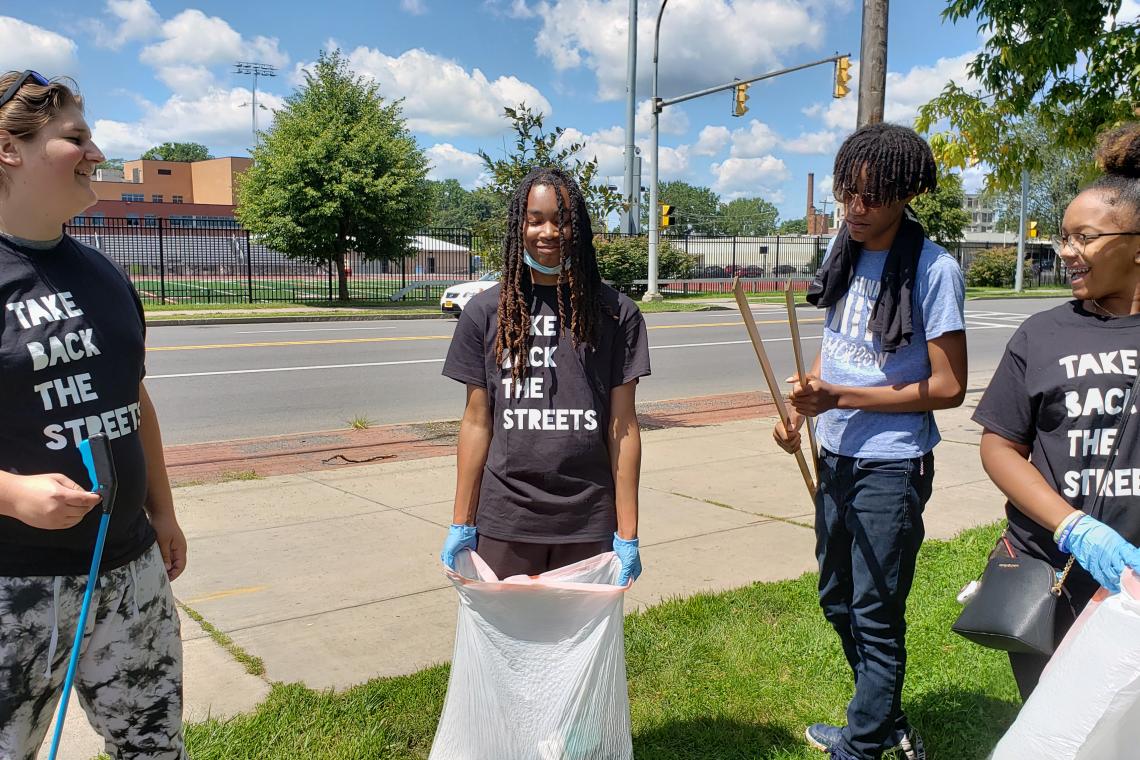
Green spaces are in short supply in historically marginalized neighborhoods, but investing in them makes for safer, healthier communities.
Building safe, thriving neighborhoods hand in hand with community members is central to Community Justice. One way we do that is by helping residents across New York create and revitalize local green spaces, using placemaking—a community-led approach to shaping public space—as a path to environmental justice.
For many low-income communities and communities of color, green spaces are in short supply. That’s the result, in part, of a long history of disinvestment, from the displacement of Black residents in the construction of New York City’s Central Park to a system of redlining that prioritized investments in some neighborhoods over others on the basis of race. The consequences of those policies are far-reaching, ranging from disparities in health and food access to upticks in crime and accidents associated with higher temperatures.
Green spaces offer opportunities for relaxation and social connection, promote physical and mental health, increase our sense of safety, and serve as sources of healthy foods. They can reduce something called the urban heat island effect, where heat gets trapped in built environments with potentially harmful effects on health, livelihood, and crime rates. At the height of the COVID-19 pandemic, they also served as places of refuge where people could see friends and family more safely.
At our Queens Community Justice Center in Jamaica, young people have the opportunity to learn about environmental justice issues while also working to address them. The Grow’n program uses urban agriculture and community gardening to teach young people about healthy food sources and environmental stewardship, help them build their job skills, and increase access to fresh food for the community as a whole. Participants learn techniques for growing and harvesting produce, preparing soil, and watering their crops, all in an anti-racist framework that explores the roots of environmental disparities. At the end of the program, young people set up in local outdoor spaces to share the knowledge and fresh food they’ve cultivated with their neighbors.
Our team in Syracuse, New York, also puts youth in the lead of transforming local green spaces with a focus on the intersection of public health and public safety. After identifying a need for safe, vibrant outdoor spaces in their neighborhood, young residents on our Youth Impact team collaborated with local nonprofits and government partners on an ongoing project to bring a vacant lot to life with trees, murals, and community events. Youth have also helped design and maintain a local community garden at our Syracuse Peacemaking Project office.
In a citywide tree planting event, the team provided meals for dozens of volunteers from the community as they planted more than 200 trees across Syracuse’s Westside, a neighborhood that has felt the effects of both environmental and economic disparities. They also encourage care and stewardship for the area’s natural beauty and infrastructure with annual community cleanups each Earth Day.
Our Neighborhood Safety Initiatives program mobilizes New York City public housing residents to lead creative projects that increase safety and well-being within their developments, including community-designed green spaces. Recently, the team partnered with tenants of the Castle Hill Houses in the Bronx to unveil a new BBQ area and dog park on their NYCHA campus—the result of participatory budgeting process in which more than 800 residents voted on a new community investment.

We’ve also harnessed the strength of our unique court-community partnerships to bring green spaces and fresh food sources to areas they’re needed most. Our Midtown Community Justice Center team worked with the Midtown South Community Council to create an urban garden in the heart of Manhattan. The garden builds awareness of healthy food options while also serving as a source of free fruits and vegetables for hungry community members. Participants at Midtown Community Justice Center had the opportunity to help cultivate crops and maintain the garden as an alternative to traditional prosecution. Over the course of two years, this partnership between the Community Justice Center and Midtown South Community Council produced and distributed 1,800 pounds of fresh produce to people living in shelters, newly arrived immigrants to the city, and families experiencing food deficits.
Health and safety are tied together, and both are shaped by the physical environment we live in. If the lack of green spaces can have a harmful impact on well-being, nutrition, crime rates, and more, investing in those spaces can have enormous upstream rewards for efforts to promote safer, healthier neighborhoods. By bringing community members, courts, and local service providers together, we can make that investment in a way that meets the needs of young people, those involved in the justice system, and people struggling with food insecurity.


